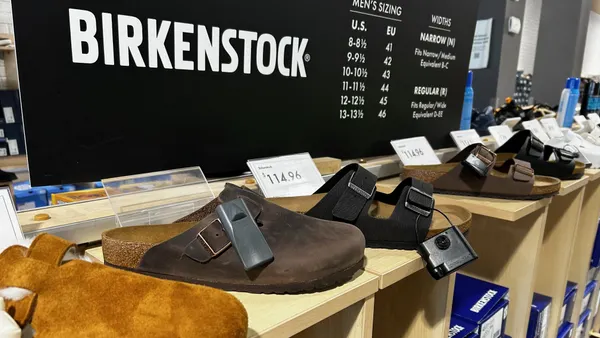Dive Brief:
-
Bed Bath & Beyond CEO Steven Temares told analysts Friday that as leases come up, the company is renegotiating terms with landlords and contemplating closures of some 80 to 100 stores in the next few years, according to a transcript from Seeking Alpha.
-
However, Temares also defended the company’s brick-and-mortar strategy, saying that, although the retailer has been criticized for not shuttering more stores, all stores are profitable and provide marketing, online order fulfillment and other opportunities to reach customers online and off.
-
The home goods retailer also said that first quarter net sales rose 0.1% to $2.74 billion, as same-store sales in the quarter, including e-commerce, fell 2.0%, compared with a decrease of 0.5% in the prior-year quarter. Digital same-store sales rose more than 20%, while brick-and-mortar same-store sales declined in the mid-single-digit percentage, according to a company press release. Shares plummeted Friday as the results missed expectations: FactSet analysts estimated net sales would reach $2.79 billion, according to MarketWatch.
Dive Insight:
Bed Bath & Beyond’s omnichannel strategy is making it somewhat difficult for executives to pinpoint the provenance of a sale. “[W]e believe in an integrated and seamless customer experience, and although we cannot tell you through which channel a sale was initiated, we can provide information based on where the sale was consummated,” CFO Susan Lattmann told analysts Friday. “...sales consummated on a mobile device while the customer is physically in store location are referred to as customer facing digital channel sale. Customer orders taken in store by an associate through the Beyond Store our proprietary web based platform are referred to as in-store sales. Customer orders reserved online and picked up in a store are also referred to as in-store sales. While purchases made online that are subsequently returned to a store are referred to as a reduction in-store sales.”
The importance of physical stores to digital sales was underscored in research last year from Moody’s Investors Service, which urged retailers to be cautious when closing stores, and take any impact on e-commerce into account. Closing a physical location reduces a retailer’s presence in the market area, and online sales often decrease in zip codes surrounding a shuttered store, that research found.
But the retailer’s bigger problem, more acute even than the slice its famous blue coupons have taken off its margins, is that it’s selling home decor and kitchen and bathroom supplies that have become commodities — easily found online at rivals, including Amazon, and vulnerable to easy price-comparisons.
To avoid that race to the bottom, the retailer has boosted its online product assortment and service offering, including improving online content to be more inspirational, making enhancements to search and navigation and creating a more frictionless checkout experience, Temares told analysts. “Also in search we continue to implement machine learning capability to further improve the relevancy of results,” Temares said. “We've simplified the navigation of our site, now introducing a new mover tab to make it easier for these customers to find relevant content and products. In addition, we've also launched a simple coupon code in checkout to allow customers to apply their favorite big blue coupon to their online order.”
Last year, in order to get a handle on the heavy discounts Bed Bath shoppers have become used to, the retailer began experimenting with a membership model to replace it. Temares said the pilot was extended in the first quarter, but that it’s too soon to tell how well it’s doing. The coupons, meanwhile, remain popular, and could be difficult to get rid of. “[W]e remain significantly driven by our coupon and it's significantly a value equation that our customers see from us,” Temares said. “And so it remains extremely important to us today.”














